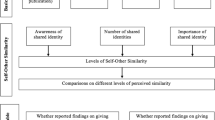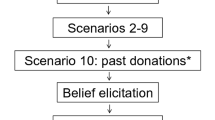Abstract
How is charitable giving influenced by other donors’ giving? Do people give more in the presence of donors who are similar to themselves? Most research suggests that individuals are positively influenced by similar others across a variety of behaviors. In the charitable giving context, if similar others donate, individuals are more likely to donate (or donate more) to the same cause. Yet, prior research has paid little attention to a potential non-linear relationship between similarity and charitable giving. Is there such thing as too much similarity? A between-subject laboratory experiment (N = 140) was designed to test a non-linear relationship between individuals’ similarity to other donors and their charitable giving. The study concludes that moderate similarity promotes more giving, yet too much similarity between donors may actually crowd out charitable giving.








Similar content being viewed by others
References
Andsager, J. L., Bemker, V., Choi, H.-L., & Torwel, V. (2006). Perceived similarity of exemplar traits and behavior: Effects on message evaluation. Communication Research, 33(1), 3–18.
Aron, A., Aron, E. N., Tudor, M., & Nelson, G. (1991). Close relationships as including other in the self. Journal of Personality and Social Psychology, 60(2), 241.
Bailenson, J. N., Iyengar, S., Yee, N., & Collins, N. A. (2009). Facial similarity between voters and candidates causes influence. Public Opinion Quarterly, 72(5), 935–961.
Bakar, H. A., & McCann, R. M. (2014). Matters of demographic similarity and dissimilarity in supervisor–subordinate relationships and workplace attitudes. International Journal of Intercultural Relations, 41, 1–16.
Baron, R. A. (1971). Aggression as a function of magnitude of victim's pain cues, level of prior anger arousal, and aggressor-victim similarity. Journal of Personality and Social Psychology, 18(1), 48–54.
Bekkers, R. (2010). George gives to geology Jane: The name letter effect and incidental similarity cues in fundraising. International Journal of Nonprofit and Voluntary Sector Marketing, 15(2), 172–180.
Ben-Ner, A., McCall, B. P., Stephane, M., & Wang, H. (2009). Identity and in-group/out-group differentiation in work and giving behaviors: Experimental evidence. Journal of Economic Behavior & Organization, 72(1), 153–170.
Boivin, M., Dodge, K. A., & Coie, J. D. (1995). Individual-group behavioral similarity and peer status in experimental play groups of boys: The social misfit revisited. Journal of Personality and Social Psychology, 69(2), 269–279.
Brewer M.B. (2016) The Social Self: On Being the Same and Different at the Same Time. Personality and Social Psychology Bulletin, 17(5), 475–482.
Burger, J. M., Messian, N., Patel, S., del Prado, A., & Anderson, C. (2004). What a coincidence! The effects of incidental similarity on compliance. Personality and Social Psychology Bulletin, 30(1), 35–43.
Byrne, D. (1961). Interpersonal attraction and attitude similarity. The Journal of Abnormal and Social Psychology, 62(3), 713.
Cialdini, R. B., & Goldstein, N. J. (2004). Social influence: Compliance and conformity. Annual Review of Psychology, 55, 591–621.
Eagly, A. H., & Koenig, A. M. (2006). Social Role Theory of Sex Differences and Similarities: Implication for Prosocial Behavior: Lawrence Erlbaum Associates Publishers.
Hamilton, W. D. (1964). The genetical evolution of social behaviour. II. Journal of Theoretical Biology, 7(1), 17–52.
Heldt, T. (2005). Conditional cooperation in the field: Cross-country skiers’ behavior in Sweden. Department of Economics and Society, Dalarna University, Sweden.
Helms, S. E., & Thornton, J. P. (2012). The influence of religiosity on charitable behavior: A COPPS investigation. The Journal of Socio-Economics, 41(4), 373–383.
Hendrick, C., & Taylor, S. P. (1971). Effects of belief similarity and aggression on attraction and counteraggression. Journal of Personality and Social Psychology, 17(3), 342–349.
Jetten, J., Spears, R., & Manstead, A. (1998). Intergroup similarity and group variability: The effects of group distinctiveness on the expression of ingroup bias. Journal of Personality and Social Psychology, 74(6), 1481–1492.
Kelman, H. C. (1958). Compliance, identification, and internalization three processes of attitude change. Journal of Conflict Resolution, 2(1), 51–60.
Konrath, S., & Handy, F. (2018). The development and validation of the motives to donate scale. Nonprofit and Voluntary Sector Quarterly, 47(2), 347–375.
Konrath, S., Bushman, B. J., & Campbell, W. K. (2006). Attenuating the link between threatened egotism and aggression. Psychological Science, 17(11), 995–1001.
Krupp, D. B., Debruine, L. M., & Barclay, P. (2008). A cue of kinship promotes cooperation for the public good. Evolution and Human Behavior, 29(1), 49–55.
Lee, L., Piliavin, J. A., & Call, V. R. (1999). Giving time, money, and blood: Similarities and differences. Social Psychology Quarterly, 276–290.
Lott, A. J., & Lott, B. E. (1965). Group cohesiveness as interpersonal attraction: A review of relationships with antecedent and consequent variables. Psychological Bulletin, 64(4), 259–309.
Mitteness, C. R., DeJordy, R., Ahuja, M. K., & Sudek, R. (2016). Extending the role of similarity attraction in friendship and advice networks in angel groups. Entrepreneurship Theory and Practice, 40(3), 627–655.
Moreland, R. L., & Zajonc, R. B. (1982). Exposure effects in person perception: Familiarity, similarity, and attraction. Journal of Experimental Social Psychology, 18(5), 395–415.
Park, J. H., & Schaller, M. (2005). Does attitude similarity serve as a heuristic cue for kinship? Evidence of an implicit cognitive association. Evolution and Human Behavior, 26(2), 158–170.
Penton-Voak, I., Perrett, D., & Peirce, J. (1999). Computer graphic studies of the role of facial similarity in judgements of attractiveness. Current Psychology, 18(1), 104–117.
Rushton, J. P., Russell, R. J., & Wells, P. A. (1984). Genetic similarity theory: Beyond kin selection. Behavior Genetics, 14(3), 179–193.
Secord, P. F., & Backman, C. W. (1964). Interpersonal congruency, perceived similarity, and friendship. Sociometry, 115-127.
Shah, P., Gaule, A., Sowden, S., Bird, G., & Cook, R. (2015). The 20-item prosopagnosia index (PI20): A self-report instrument for identifying developmental prosopagnosia. Royal Society Open Science, 2(6), 140343.
Shang, J., Croson, R., & Reed, A. (2007). “I” give, but “we” give more: The impact of identity and the mere social information effect on donation behavior. NA-Advances in Consumer Research Volume, 34.
Silvia, P. J. (2005). Deflecting reactance: The role of similarity in increasing compliance and reducing resistance. Basic and Applied Social Psychology, 27(3), 277–284.
Sinervo, B., & Clobert, J. (2003). Morphs, dispersal behavior, genetic similarity, and the evolution of cooperation. Science, 300(5627), 1949–1951.
Sole, K., Marton, J., & Hornstein, H. A. (1975). Opinion similarity and helping: Three field experiments investigating the bases of promotive tension. Journal of Experimental Social Psychology, 11(1), 1–13.
Strahan, R., & Gerbasi, K. C. (1972). Short, homogeneous versions of the Marlowe-Crowne social desirability scale. Journal of Clinical Psychology.
Tian, Y., & Konrath, S. (2019). The effects of similarity on charitable giving in donor–donor dyads: A systematic literature review. Voluntas: International Journal of Voluntary and Nonprofit Organizations, 1-24. (Online First).
USA, G. (2019). The Annual Report on Philanthropy for the Year, 2018.
Van Hoye, G., & Turban, D. B. (2015). Applicant–employee fit in personality: Testing predictions from similarity-attraction theory and trait activation theory. International Journal of Selection and Assessment, 23(3), 210–223.
Woodside, A. G., & Davenport, J. W. (1974). The effect of salesman similarity and expertise on consumer purchasing behavior. Journal of Marketing Research, 11(2), 198–202.
Yinon, Y., & Sharon, I. (1985). Similarity in religiousness of the solicitor, the potential helper, and the recipient as determinants of donating behavior. Journal of Applied Social Psychology, 15(8), 726–734.
Author information
Authors and Affiliations
Corresponding author
Ethics declarations
Conflict of Interest
On behalf of all authors, the corresponding author states that there is no conflict of interest.
Research Involving Human Participants
All procedures performed in studies involving human participants were in accordance with the ethical standards of the institutional and/or national research committee and with the 1964 Helsinki declaration and its later amendments or comparable ethical standards.
Informed Consent
Informed consent was obtained from all individual participants included in the study.
Data Statement
The datasets generated during and/or analyzed during the current study are not publicly available due the funding restriction but are available from the corresponding author on reasonable request.
Additional information
Publisher’s Note
Springer Nature remains neutral with regard to jurisdictional claims in published maps and institutional affiliations.
Electronic supplementary material
ESM 1
(DOCX 15 kb)
Rights and permissions
About this article
Cite this article
Tian, Y., Konrath, S. Can too much similarity between donors crowd out charitable donations? an experimental investigation of the role of similarity in social influence on giving behavior. Curr Psychol 40, 1546–1558 (2021). https://doi.org/10.1007/s12144-020-00616-4
Published:
Issue Date:
DOI: https://doi.org/10.1007/s12144-020-00616-4




